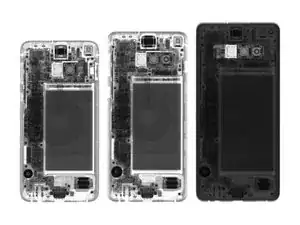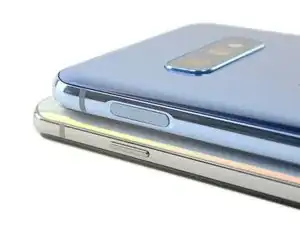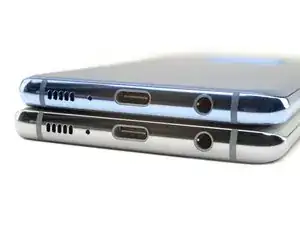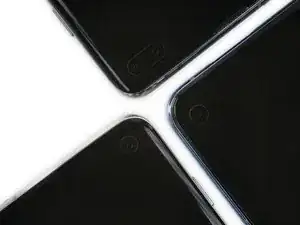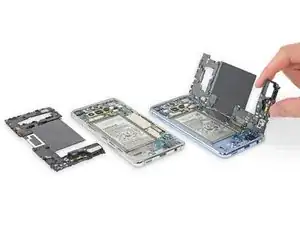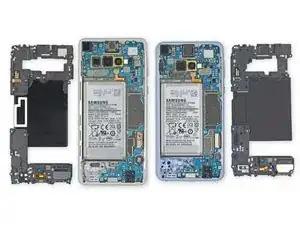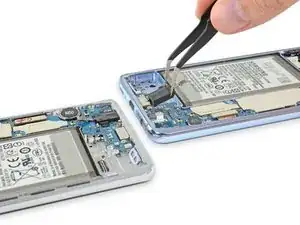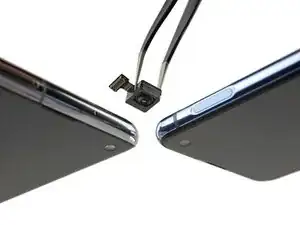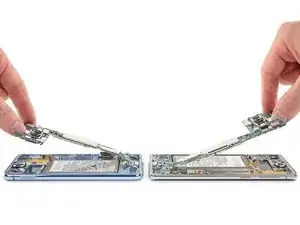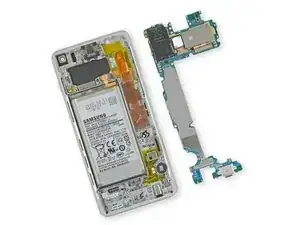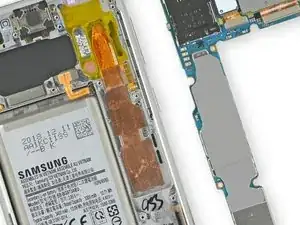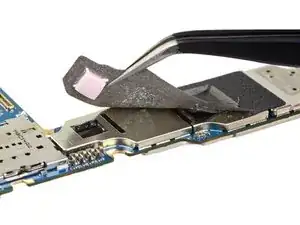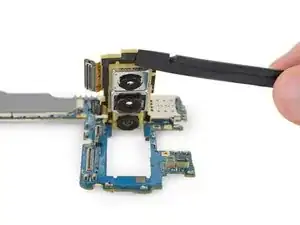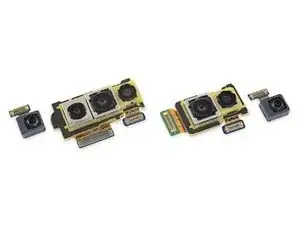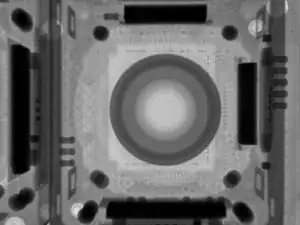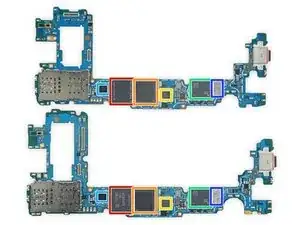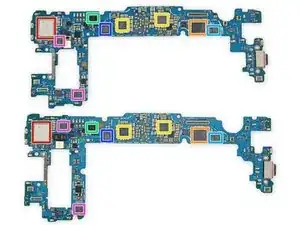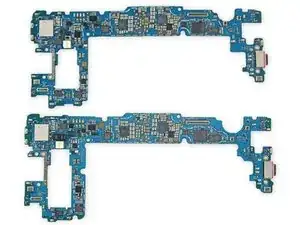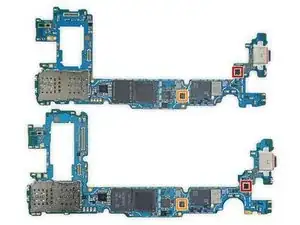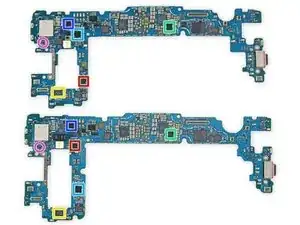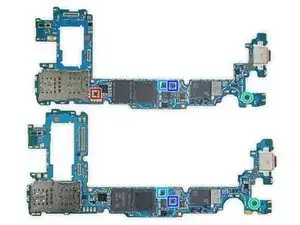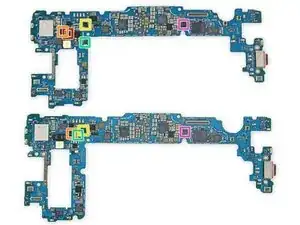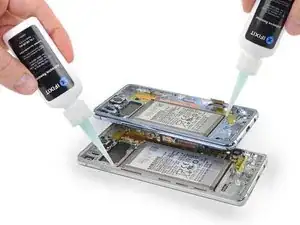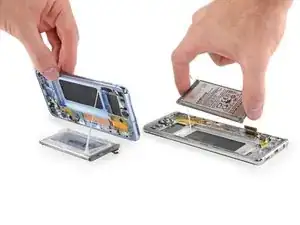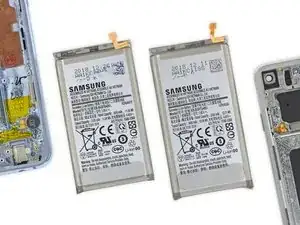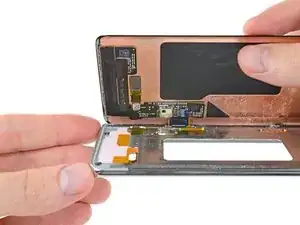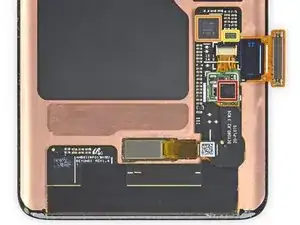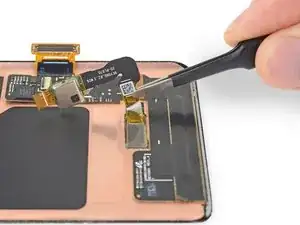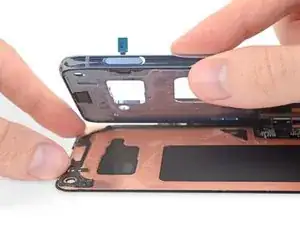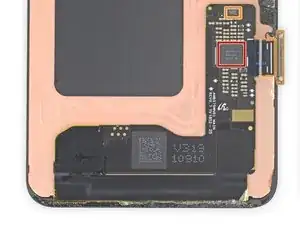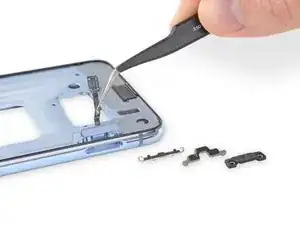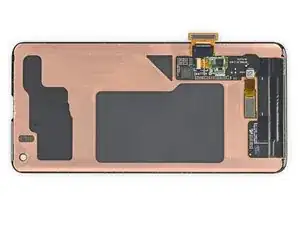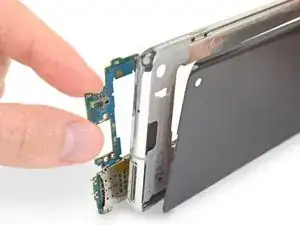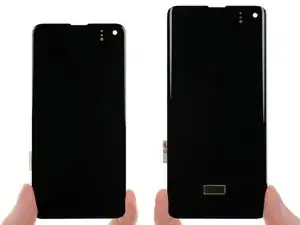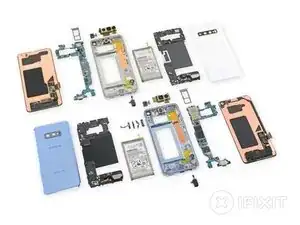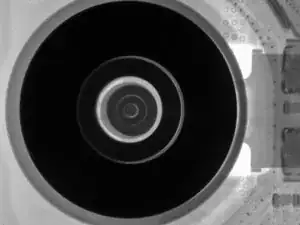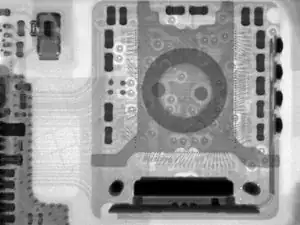Introduction
After the iPhone’s sudden foray into Roman numerals, we half expected Samsung to give us a Galaxy SX. But here we are, with the all-too-predictably-named S10 and S10e. Are they really as plain as their names suggest? Only one way to find out—time for a teardown!
For even more exciting news and teardowns, follow us on Twitter, Instagram, and Facebook. For iFixit delivered, check out our newsletter.
Tools
-
-
What exactly puts the "e" in S10e, and keeps it out of the S10? Let's see if the specs tell us anything:
-
Super AMOLED Infinity-O displays—5.8" (2280 × 1080) on the S10e and 6.1" (3040 × 1440) on the S10
-
Qualcomm Snapdragon 855 processor (or Samsung Exynos 9820 in some regions)
-
10-megapixel selfie camera and a rear-facing camera, with one dual-aperture 12 MP wide-angle module and one 16 MP ultra wide module—plus, the S10 gets one additional 12 MP telephoto module
-
A conventional fingerprint sensor in the S10e's side button, vs. the new ultrasonic fingerprint sensor hidden under the S10's display
-
Headphone jack and microSD card slot
-
IP68 water/dust-resistance rating
-
-
-
These phones' monolithic facades don't reveal much right off the bat, though we note the curved display edges on the S10 and S10+.
-
From the back we spot two different camera lineups: all of the phones sport wide-angle and ultra-wide cameras, but the S10 and S10+ get bonus telephoto cameras.
-
While we're stuck looking at phones like it's 1894, Creative Electron delivers state of the art X-ray photos to help us unmask these phones.
-
A dense ceramic back cover makes the S10+ far more opaque to X-rays than its glass-backed companions. In other words, it's dark.
-
-
-
While these phones sport similar exteriors, the budget-friendly S10e gets a noticeably bigger power button—where its conventional, capacitive fingerprint sensor is housed.
-
The S10 plays things a little closer to the vest, with a fingerprint sensor you can't even see ... without a teardown, that is.
-
Despite their subtle differences, the S10 and S10e both agree that headphone jacks are still pretty cool. They've also got matching USB-C, mic, and speaker ports.
-
At the top of the phones, we get our first (in-person) glimpse at some "hole-punch" displays—complete with preinstalled screen protectors.
-
-
-
With a new and improved phone comes a new and improved opening procedure ... or not! Once again we must heat things up and put our trusty iSclack to work.
-
We pull the backs off our phones, waiting for some kind of trap. Not this time, Admiral Ackbar! The panels come right off.
-
Also, did we imagine it, or is the adhesive a little less stubborn this time?
-
Just as things are cooling down, we notice heat-dissipating graphite pads strategically placed on these back covers. Something in here is designed to get hot without burning your fingers.
-
-
-
Just a few standard Phillips screws stand between us and the good stuff. Our Marlin driver set has us covered, but we're glad that Samsung only has us using one driver for now.
-
These midframe assemblies with their integrated coils have learned a new trick: they can now wirelessly charge other devices.
-
That's probably why the coils are sandwiched between two layers of graphite this year—a wireless charger that transmits as well as receives will produce a lot more heat.
-
-
-
Samsung's headphone jacks are only about 12 mm tall and 8 mm across, and they're 100% modular, which we really like. It's just a shame there's not enough room for one in an iPhone—or even an iPad.
-
We'll talk cameras in a moment, but for now we jettison the selfie cams to make way for motherboard extraction.
-
Our teardown engineer executes a flawless synchronized motherboard lift ...
-
-
-
Taking a peek beneath the motherboard, we make a couple cool observations.
-
That massive copper heat pipe under the board is much beefier than the one in the S9—it looks more like the one we found in the Note9.
-
Meanwhile, we peel off an additional, multi-layer piece of thermal interface material from the board. All that copper makes a great, big, flat surface, for better thermal transfer—but it's soft metal, so you need this soft interface to fill in any gaps that might otherwise kill performance or overheat your phone.
-
This thin sticker also seems to provide some RF shielding, as there's a big hole in the can lid underneath—where we find a PMIC and a big pink thermal pad.
-
TL;DR: We surmise that fast charging + reverse wireless charging puts some serious thermal stress on the electronics in this system. Samsung has pulled out all the stops to cool it off.
-
-
-
Next we pop the main camera array off the board—it comes encased in a yellow plastic frame, likely ABS or nylon in its natural, un-dyed color. (It looks a little 80's, but we don't mind.)
-
We plop both camera arrays down next to their respective selfie cams (by themselves at far left and far right).
-
The S10's array (left) gets one more camera than the S10e—a 12 MP, ƒ/2.4 telephoto with OIS—and sticks it on the same connector as the standard wide-angle camera.
-
Further physical teardown would get pretty destructive, but here's an X-ray showing the telephoto camera's sensor and OIS electromagnets.
-
The 12 MP wide-angle cameras also get OIS, as well as the trick dual-aperture setup from the S9+.
-
Finally, the 16 MP, ƒ/2.2 ultra wide modules have slightly thicker plastic frames.
-
-
-
Thermal pads and cameras aside, let's get to those chips! On the front side of these motherboards (top: S10e, bottom: S10), we spot:
-
S10e: THGAF8T0T43BAIR 128 GB Toshiba UFS NAND flash storage
-
S10: KLUFG8R1EM-B0C1 512 GB Samsung eUFS NAND flash storage
-
Samsung K3UH7H70AM-AGCL LPDDR4X layered over Qualcomm Snapdragon 855 SoC
-
Qualcomm WCD9341 audio codec
-
Qorvo QM78062, likely a RF Fusion front-end module
-
Maxim MAX77705C PMIC
-
Skyworks SKY78160-51 Low Noise Amplifier
-
-
-
Never one to under-deliver, Samsung packed even more silicon on the flip sides:
-
Murata KM8D03042 (likely Wi-Fi/Bluetooth module)
-
Qualcomm SDR8150 RF Tranceiver
-
Qualcomm PM8150 Power Management
-
IDT P9320S wireless power receiver
-
Qorvo QM78062 Power Amplifier Module (likely)
-
NXP PN80T NFC controller w/ Secure Element
-
Qualcomm QDM3870 RF front end module
-
-
-
Now that we've seen the bigger names, lets dive deeper and take a look at the little guys:
-
Cirrus Logic CS35L40 audio amplifier
-
Qualcomm QET5100 envelope tracker
-
Skyworks SKY13716-11 low-band LNA front-end module
-
Likely a Samsung S2DOS05 display power management IC
-
Likely a Samsung S2MPB02 camera power management IC
-
STMicroelectronics STM32G071EBY6 32-Bit Arm Cortex-M0+ microcontroller with 128 Kb flash memory
-
NXP Semiconductor BGU8103 GPS/GLONASS/Galileo/COMPASS low noise amplifier
-
-
-
Last, but not least:
-
STMicroelectronics LPS22HH pressure sensor
-
STMicroelectronics LSM6DSO accelerometer
-
Samsung S2MIS01 MST driver
-
Likely a Diodes Incorporated AH1897T Hall Effect sensor
-
Vishay DG2730 USB 2.0 DPDT analog switch
-
NXP Semiconductor NCX2200 low voltage comparator
-
RDA Microelectronics RDA6213N FM transceiver (likely)
-
-
-
Battery time! To no one's surprise, these two batteries are heavily adhered to their metal midframes, with no friendly pull tabs in sight.
-
Not to worry though—we bust out our trusty adhesive remover and set up a beautiful "water" feature while we wait for the adhesive to lower its defenses.
-
These portable power plants are rocking 11.94 Wh for the left-hand S10e and 13.09 Wh for the right-hand S10 (a 13% increase over last year's 11.55).
-
For comparison's sake, the competing iPhones sport 11.16 Wh (XR) and 10.13 Wh (XS) respectively.
-
-
-
With nowhere left to turn, we boldly take our chances removing these delicate displays. Once inside the S10, we spot the new ultrasonic fingerprint-sensing getup.
-
Qualcomm QBT2000 Ultrasonic Fingerprint Sensor Controller
-
The tech may be novel, but our praise ends there. We threw just about everything we could at this little guy and it is not coming out intact.
-
If Samsung has any repair tips they'd like to share, we're all ears. For now, assume you're going to pay an arm and a leg for a new screen should the sensor malfunction.
-
Other ICs:
-
Samsung S6SY771X Touchscreen Controller
-
Winbond W25Q80EWUXIE 8 Mb Serial Flash Memory
-
-
-
The flat display on the S10e is just barely less scary to remove than the curved S10 screen. Unfortunately, we doubt either of these displays will live to play another game of Fortnite.
-
The S10e has no cool ultrasonic technology glued to the back of its display, but it does have a familiar face:
-
Samsung's S6SY761X touch controller IC—the same IC the S9 displays sported last year, and the S8 phones before them.
-
GigaDevice GD25LH40C 4 Mb Serial Flash Memory
-
Here's a closer look at that capacitive touch sensor we mentioned earlier, integrated into the power button.
-
Unfortunately this repair procedure leaves much to be desired, requiring full screen removal to access the button.
-
-
-
These super-thin, Samsung-made displays act as yet another thermal management tool—backed by layers of copper and graphite to dissipate the heat generated by other components inside the phone.
-
The camera hole punched into those layers is, of course, intentional and carved away "pixel by pixel" by a laser. The hole runs through both midframe and motherboard back to the camera itself.
-
Unlike the camera, the hidden proximity and fingerprint sensors can "see" directly through the OLED matrix, allowing for the most "edge-to-edge" screen we've seen in a teardown. You'd probably never see them during normal use, but here with the displays detached, they're easy to spot.
-
-
-
We tore down two whole phones for your viewing pleasure, but here's the TL;DR in case you're in a hurry:
-
Big batteries, still glued in and not easily replaceable.
-
Wireless charging of other devices from these phones makes a lot of heat, and probably isn't great for long-term battery life.
-
The displays are pretty nifty, but replacements will still be pricey and difficult—and the new placement of the fingerprint sensors doesn’t help matters.
-
But wait, there's more! Act now and you're eligible for a third FREE teardown—we've got a video teardown of the S10+!
-
With that, it's time to face the music and give these phones a score.
-
-
-
Samsung's Galaxy S10 and S10e each earn a 3 out of 10 on our repairability scale (10 is the easiest to repair):
-
A single Phillips driver takes care of all the screws.
-
Many components are modular and can be replaced independently—but the charging port is now soldered to the main board.
-
Battery replacement is possible, but still unnecessarily difficult.
-
Glued-down glass both front and back means greater risk of breakage, and makes repairs difficult to start.
-
Screen repairs require a lot of disassembly while battling tough adhesive.
-
33 comments
Guess I'll take a pass on the S10 this time.
Just curious, no Broadcom chips at all in this Galaxy iteration? No BCM4375?
There is a Broadcom present in the SM-G973F/DS model. A BCM4775 GNSS receiver. Have a look here https://www.chiprebel.com/galaxy-s10-tea...
How about proximity sensor in the S10+ and S10? Since every component need to be under screen.
Is this possible to have more cleared or close picture about that, thanks!
I would also love to get a better understanding on who is supplying the S10 with the under display proximity sensor
It’s going to be almost near impossible for handyman individuals to replace phone batteries in the upcoming years. Companies are implementing methods to further complicate repairing/replacing procedures. I don’t see an incentive in buying a $900- $1,100 smartphone that will only last 3 years (if battery use is moderated to a minimum). To make matters worse, third-party vendors like iFixit aren’t improving their tools necessary in making it easier to repair/replace. As repairing/replacing prices climb higher and higher every year by $20, it is becoming more unlikely in even considering repairing or replacing something simple like a phone battery for the upcoming years.
As a repair tech, I get to disassemble a lot of different models, and get to work on models still pretty new on the market (so my reasoning is not outdated). And while disassembly have gotten a bit more difficult since the era of pop-off rear covers and rigid-housing batteries, in regards to battery replacement, for the most part it hasn't changed much the last 5+ years. And it it likely won't change much anytime soon. Because this is a job the manufacturers and partners need to do themselves, A LOT.
The tools haven't changed significantly, nor have the procedure. Just need to check the ifixit guides to make sure you're aware where any flex cables and other protruding parts are, so you don't break any while opening. General rule of thumb (but always check ifixit to verify): With iphones you go in from the front, bottom to top, and there are flex cables along 1 long-side. (Almost) everyone else, go in from the back, top to bottom to not accidentally get under the Qi or NFC coils and cut them.




